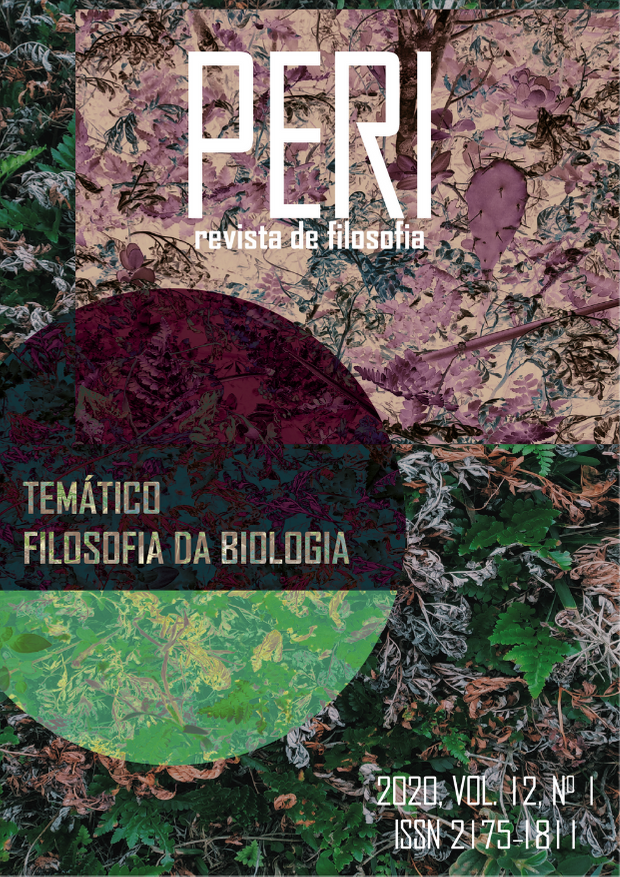Falconer, Darwin y el Derecho Anglosajón: Como Repensar la “Estructura” de la Teoría Evolutiva
Palavras-chave:
Estructura Teórica, Teoría Evolutiva, Estructuralismo Metateórico, Modelos, Síntesis Moderna, Síntesis ExtendidaResumo
En su Opus Magnum, La Estructura de la Teoría de la Evolución, Stephen J. Gould argumentaba que hay dos maneras principales de representar la estructura de la teoría evolutiva: de manera jerárquica y fundacional, como defendido por el paleontólogo escocés Hugh Falconer, y por medio de una forma más abierta y flexible, respaldada por el mismo Darwin. A la luz de la literatura más reciente, en este artículo pretendemos reconsiderar la propuesta de Gould y contestar la siguiente pregunta: ¿La estructura de la teoría evolutiva debería representarse en términos falconerianos, darwinianos, gouldiano o de alguna otra forma? En primer lugar, aclaramos lo que deberíamos entender con los conceptos de “teoría”, “estructura” y “contenido”. En segundo lugar, utilizando metafóricamente el sistema del derecho Anglosajón, esclarecemos en qué sentido la estructura de la teoría evolutiva puede ser considerada coherente y relativamente bien articulada (y no un conjunto fragmentado de modelos). Y, en tercer lugar, defendemos la hipotesis de que la coherencia y articulación de la estructura teórica no requiere una organización u orden jerárquico.
Referências
Balganesh S., Parchomovsky G. (2015) Structure and Value in the Common Law, Law Review, 1141.
Balzer, W., Moulines, C. U. y Sneed, J. D. (1987) An Architectonic for Science. The Structuralist Program. Dordrecht: Reidel.
Beatty J. (1997) Why Do Biologists Argue Like They Do? Philosophy of Science 63, pp. 432-443.
Cardozo B. (1949) The Nature of the Judicial Process, New Haven: Yale University Press.
Carnap, R. (1939) Foundations of Logic and Mathematics. Chicago: University of Chicago Press.
Coyne, J. A., Barton, N. H., and Turelli, M. (2000) Is Wright’s Shifting Balance Process Important in Evolution? Evolution 54, 306-317.
Diez, J. A. y Moulines, C. U (1997) Fundamentos de filosofía de la ciencia. Barcelona: Ariel.
Fabregas-Tejeda, Vergara Silva, (2018) The emerging structure of the Extended Evolutionary Synthesis: where does Evo-Devo fit in? Theories in Biosciences 137: 169–184.
Frank, S. A. (2012) Natural selection. IV. The Price equation. Journal of Evolutionary Biology, 25, pp. 1002–1019.
Frigg R. (2020) Models in Science. In The Stanford Encyclopedia of Philosophy https://plato.stanford.edu/entries/models-science/
Futuyama J. D. (2017) Evolutionary biology today and the call for an extended synthesis, Interface Focus 7: 20160145
Ginnobili, S. (2010) La teoría de la selección natural darwiniana y la genética de poblaciones. Éndoxa, 24, pp. 169–183.
Ginnobili, S. (2018) La teoría de la selección natural. Una exploración metacientífica. Bernal: Universidad Nacional de Quilmes.
Gould S. J. (2002) The Structure of Evolutionary Theory, Cambridge: Harvard University Press.
Kuhn, T. S. (1970) Second Thoughts on Paradigms. In F. Suppe (ed) The Structure of Scientific Theories. Urbana: University of Illinois Press, pp. 459–482.
Laland K. N, Uller T, Feldman M.W, Sterelny K, Muller G.B, Moczek A, Jablonka E, Odling-Smee J. (2015) The extended evolutionary synthesis: its structure, assumptions and predictions. Proc. R. Soc. B 282: 20151019.
Lewens T. (2019). The Extended Evolutionary Synthesis: What is the debate about, and what might success for the extenders look like? Biological Journal of the Linnean Society, 127 (4), 707-721.
Love A, (2010) Rethinking the structure of evolutionary theory for an extended synthesis. In Evolution—The Extended Synthesis. Eds. Pigliucci M; Müller G. Cambridge, MIT Press, pp. 403-441.
Love A. (2012) Theory is as Theory Does: Scientific Practice and Theory Structure in Biology, Biological Theory 7: 325–337.
Love A. (2017) Evo-devo and the structure(s) of evolutionary theory: A different kind of challenge. In Challenging the Modern Synthesis: Adaptation, Development, and Inheritance, Eds. Huneman P and Walsh D. Oxford: Oxford University Press, pp. 159-187.
Luque, V. J. (2017) One Equation to Rule Them All: A Philosophical Analysis of the Price Equation. Biology and Philosophy, 32, pp. 97–125.
Pigliucci M, Muller G (2010), Evolution - The Extended Synthesis, Cambridge, MIT Press.
Provine W. B. (1985) The R.A. Fisher–Sewall Wright Controversy and its Influence Upon Modern Evolutionary Biology, in Dawkins, R. and Ridley, M. (ed.) Oxford Surveys in Evolutionary Biology, Vol. 2, Oxford University Press, New York, pp. 197-219.
Winther, R. G. (2016) The Structure of Scientific Theories. In E. N. Zalta (ed) The Stanford Encyclopedia of Philosophy. Disponible en: https://plato.stanford.edu/archives/win2016/entries/ structure-scientific-theories/
Downloads
Publicado
Edição
Seção
Licença
- Autores mantém os direitos autorais e concedem à revista o direito de primeira publicação, com o trabalho simultaneamente licenciado sob a Creative Commons Attribution License que permite o compartilhamento do trabalho com reconhecimento da autoria do trabalho e publicação inicial nesta revista.
- Autores têm autorização para assumir contratos adicionais separadamente, para distribuição não-exclusiva da versão do trabalho publicada nesta revista (ex.: publicar em repositório institucional ou como capítulo de livro), com reconhecimento de autoria e publicação inicial nesta revista.
- Autores têm permissão e são estimulados a publicar e distribuir seu trabalho online (ex.: em repositórios institucionais ou na sua página pessoal) a qualquer ponto antes ou durante o processo editorial, já que isso pode gerar alterações produtivas, bem como aumentar o impacto e a citação do trabalho publicado (Veja O Efeito do Acesso Livre).





